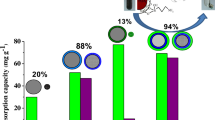Abstract
Magnetite (Fe3O4) is an important biomineral, e.g., used by magnetotactic bacteria. The connection between the inorganic magnetite-(111)-surface and the organic parts of the bacteria is the magnetosome membrane. The membrane is built by different magnetosome membrane proteins (MMPs), which are dominated by the four amino acids glycine (Gly), aspartic acid (Asp), leucine (Leu) and glutamic acid (Glu). Force field simulations of the interaction of the magnetite-(111)-surface and the main amino acid compounds offer the possibility to investigate if and how the membrane proteins could interact with the mineral surface thus providing an atomistic view on the respective binding sites. In a force field simulation the four amino acids were docked on the Fe-terminated magnetite-(111)-surface. The results show that it is energetically favorable for the amino acids to adsorb on the surface with Fe-O-distances between 2.6 Å and 4.1 Å. The involved O-atoms belong to the carboxyl-group (Asp and Glu) or to the carboxylate-group (Gly, Leu and Glu). Electrostatic interactions dominate the physisorption of the amino acids. During the simulations, according to the frequency of the best results, the global minimum for the docking interaction could be attained for all amino acids analyzed.







Similar content being viewed by others

References
Fleet ME (1981) Acta Crystallogr B 37:917–920
Wright JP, Attfield JP, Radaelli PG (2001) Phys Rev Lett 87:266401
Ritter M, Weiss W (1999) Surf Sci 432:81–94
Martin GJ, Cutting RS, Vaughan DJ, Warren MC (2009) Am Mineral 94:1341–1350
Grillo ME, Finnis MW, Ranke W (2008) Phys Rev B 77:075407
Suzuki Y, Hu G (2002) Phys Rev Lett 89:276601
Lowenstam HA, Weiner S (1989) On biomineralization. Oxford University Press, New York
Grünberg K, Müller EC, Otto A, Reszka R, Lindner D, Kube M, Reinhardt R, Schüler D (2004) Appl Environ Micro 70:1040–1050
Schüler D (2004) Arch Microbiol 181:1–7
Bäuerlein E (2003) Angew Chem Int Ed Engl 42:614–641
Gotliv BA, Addadi L, Weiner S (2003) Chem Biochem 4:522–529
Magdans U, Torrelles X, Angermund K, Gies H, Rius J (2007) Langmuir 23:4999–5004
Pareek A, Torrelles X, Angermund K, Rius J, Magdans U, Gies H (2009) Langmuir 25:1453–1458
Pareek A, Torrelles X, Angermund K, Rius J, Magdans U, Gies H (2009) Langmuir 24:2459–2464
Sauer J, Ugliengo P, Garrone E, Saunders VR (1994) Chem Rev 94:2095–2160
Nair NN, Schreiner E, Marx DJ (2006) J Am Chem Soc 128:13815–13826
Pollet R, Boehme C, Marx D (2006) Orig Life Evol B 36:363–379
Lide DR (1997) Handbook of chemistry and physics, 78th edn. CRC, New York
Sun HJ (1998) J Phys Chem B 102:7338–7364
Cao G, Chen X (2006) Nanotechnology 17:3844–3855
Wang Q, Liew KM, Duan WH (2008) Carbon 46:285–290
Kulathunga DDTK, Ang KK, Reddy NN (2010) J Phys-Condens Mat 22:345301
Zhu L, Yao KL, Liu ZL (2006) Phys Rev B 74:035409
Nyberg M, Hasselstrom O, Karis O, Wassdahl N, Weinelt M, Nilsson A, Pettersson LGM (2000) J Chem Phys 112:5420
Guo Y, Lu X, Zhang H, Weng J, Watari F, Leng Y (2011) J Phys Chem C 115:18572–18581
Author information
Authors and Affiliations
Corresponding author
Additional information
An erratum to this article is available at http://dx.doi.org/10.1007/s00894-016-3124-8.
Rights and permissions
About this article
Cite this article
Bürger, A., Magdans, U. & Gies, H. Adsorption of amino acids on the magnetite-(111)-surface: a force field study. J Mol Model 19, 851–857 (2013). https://doi.org/10.1007/s00894-012-1606-x
Received:
Accepted:
Published:
Issue Date:
DOI: https://doi.org/10.1007/s00894-012-1606-x


